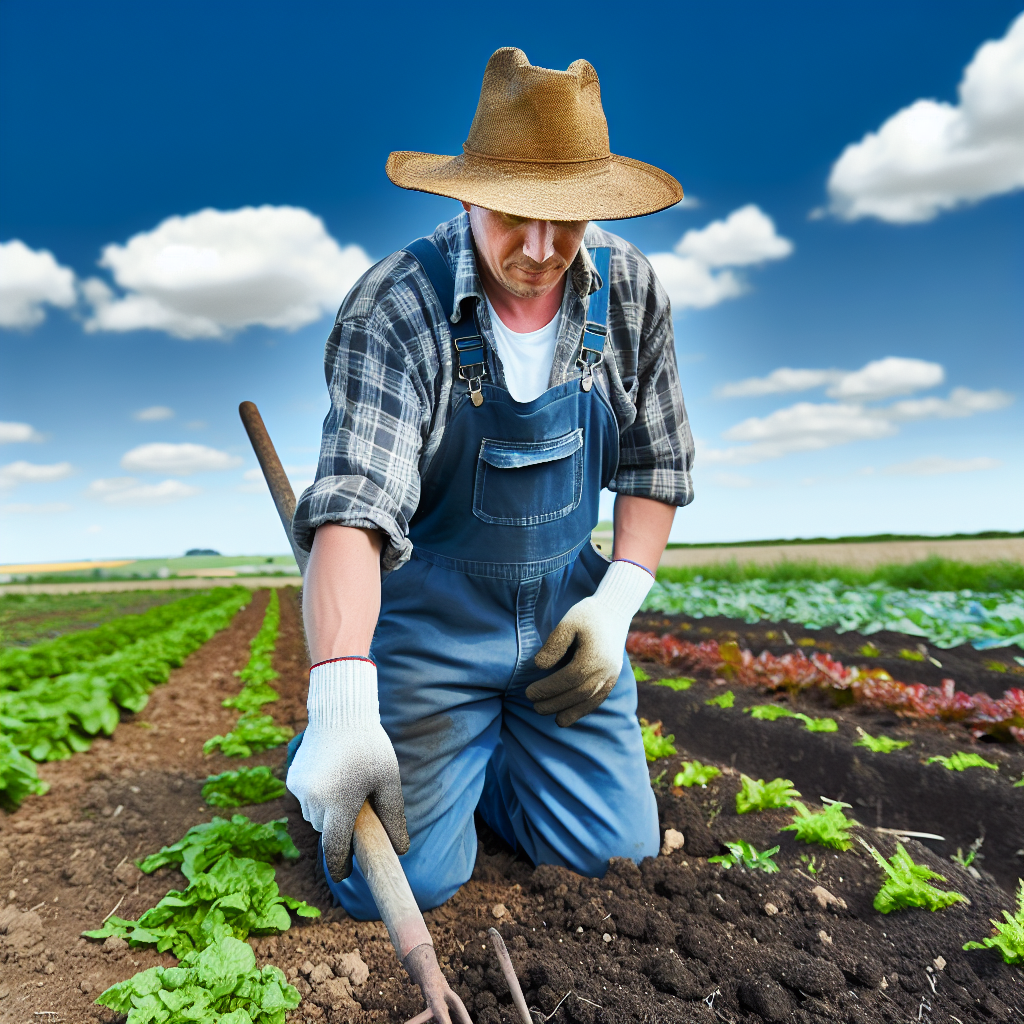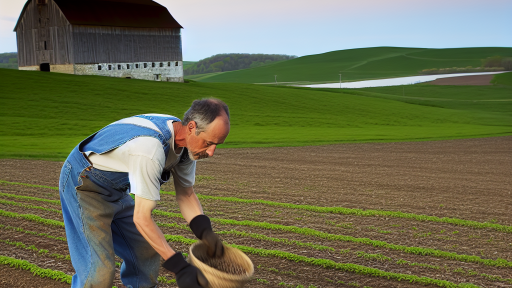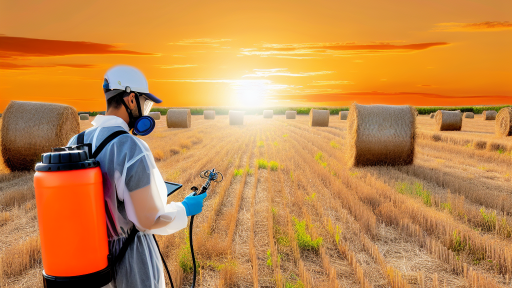Introduction to Mulching and Its Role in Crop Cultivation
Mulching is an effective agricultural practice for crop cultivation.
It involves covering the soil surface with material to improve growing conditions.
This practice plays a crucial role in pest management within crops.
Firstly, mulching suppresses the growth of weeds.
Consequently, less competition arises for nutrients and water.
Moreover, it helps maintain soil moisture levels efficiently.
This results in healthier crop growth overall.
Furthermore, organic mulches contribute to soil fertility when they decompose.
They enhance microbial activity and improve soil structure.
In addition, mulching provides a habitat for beneficial insects.
These insects can play a key role in controlling pest populations.
Farmers should consider implementing this strategy for effective crop cultivation.
Types of Mulching Materials and Their Benefits for Pest Management
Organic Mulching Materials
Organic mulches come from natural sources like leaves, straw, or wood chips.
They enhance soil fertility as they decompose over time.
Additionally, organic mulches provide habitat for beneficial insects.
Transform Your Agribusiness
Unlock your farm's potential with expert advice tailored to your needs. Get actionable steps that drive real results.
Get StartedThese insects help control pest populations effectively.
Moreover, organic mulches can suppress weed growth, reducing competition for crops.
Inorganic Mulching Materials
Inorganic mulches include materials such as plastic or landscape fabric.
They create a physical barrier that prevents pests from reaching plants.
These materials also retain soil moisture, reducing irrigation needs.
Furthermore, they can reflect light, which deters certain pests.
Inorganic options are long-lasting and require less maintenance.
Benefits of Mulching for Pest Management
Mulching promotes a healthier crop environment through various mechanisms.
It improves soil structure and organic matter, creating a more fertile ground.
This practice attracts beneficial organisms that prey on common pests.
Also, mulching retains soil moisture, reducing water stress on plants.
Healthy plants are less vulnerable to pest infestations.
Application Techniques for Effective Pest Management
Apply mulch during the growing season for maximum effectiveness.
Ensure even distribution around the base of plants to form a protective layer.
A depth of 2-4 inches usually works best for organic materials.
Regularly check for any buildup of pests in the mulch.
Adjust your mulching strategy based on the specific crop and pest profile.
How Mulching Affects Soil Health and Crop Resilience
Improving Soil Structure
Mulching significantly enhances soil structure.
It increases the soil’s ability to retain moisture.
Moreover, it reduces soil erosion caused by wind and water.
This process fosters the development of beneficial soil organisms.
Additionally, it enhances organic matter content in the soil.
Regulating Soil Temperature
Mulch acts as an insulating layer for the soil.
This insulation helps maintain consistent soil temperatures.
Showcase Your Farming Business
Publish your professional farming services profile on our blog for a one-time fee of $200 and reach a dedicated audience of farmers and agribusiness owners.
Publish Your ProfileIn summer, mulch keeps the soil cooler.
In contrast, it warms the soil during colder months.
Consequently, plants experience less stress from temperature fluctuations.
Enhanced Nutrient Availability
Organic mulch decomposes, contributing nutrients to the soil.
This process enhances nutrient cycling within the ecosystem.
As a result, plants have better access to essential nutrients.
Furthermore, microbes benefit from the nutrient-rich environment.
Healthy microbial activity improves nutrient uptake for crops.
Water Conservation
Mulching reduces water evaporation from the soil surface.
This leads to significant water conservation in crop cultivation.
Irrigation becomes more efficient and cost-effective with mulch.
The soil remains moist, supporting plant growth during dry spells.
Consequently, crops exhibit better resilience against drought conditions.
Pest and Weed Management
Mulching suppresses the growth of weeds effectively.
This competition for resources diminishes, benefiting crops.
Additionally, mulching provides habitats for beneficial insects.
By attracting these insects, it can enhance pest management.
The balance of ecosystems remains intact through this approach.
Encouraging Biodiversity
Healthy soil promotes a diverse range of organisms.
Mulching supports various beneficial insects and microorganisms.
This biodiversity contributes to crop resilience and productivity.
Furthermore, it enhances ecosystem stability.
Ultimately, a diverse ecosystem bolsters pest management strategies.
You Might Also Like: Benefits of Mulching for Soil Structure and Fertility
The Impact of Mulching on Pest Populations and Their Natural Predators
Understanding Mulching
Mulching refers to covering the soil with organic or inorganic materials.
This technique creates a barrier against pests.
Mulch can also provide nutrients to the soil.
Effects on Pest Populations
Mulching significantly influences pest populations.
It can reduce the number of harmful insects.
By blocking their access, mulch protects young plants.
Moreover, certain materials attract beneficial insects.
Supporting Natural Predators
Mulching creates a habitat for natural predators.
Predators such as ladybugs thrive in mulched areas.
This biodiversity helps manage pest populations effectively.
Furthermore, well-chosen mulch can harbor pollinators.
Types of Mulch Beneficial for Pest Management
- Organic mulch, such as wood chips, suppresses weeds.
- Straw mulch attracts beneficial insects.
- Rubber mulch may deter some crawling pests.
Implementing Mulching Techniques
To maximize benefits, apply mulch correctly.
Start with a layer of at least three inches.
Ensure the mulch does not touch plant stems.
This prevents rot and pest infestations.
Monitoring and Maintenance
Regularly inspect mulched areas for pest activity.
Showcase Your Farming Business
Publish your professional farming services profile on our blog for a one-time fee of $200 and reach a dedicated audience of farmers and agribusiness owners.
Publish Your ProfileAlso, maintain mulch thickness throughout the growing season.
Replace any decomposed mulch to continue its benefits.
Delve into the Subject: Crop Rotation Strategies for Healthy Soils
Case Studies Showcasing Successful Pest Management Through Mulching
Case Study: Organic Vegetable Farm
An organic vegetable farm in California adopted mulching techniques to manage pests.
They used straw and wood chips as mulch around their crops.
This method reduced aphid populations by providing habitat for beneficial insects.
Additionally, mulching conserved soil moisture, promoting healthy plant growth.
The farm enjoyed a 30% decrease in pesticide use over three years.
Case Study: Berry Farm
A berry farm in Oregon implemented mulching to tackle fungal diseases.
They applied a layer of grass clippings around their berry plants.
This practice minimized soil splash during rain, reducing disease spread.
Furthermore, the mulch helped suppress weed growth that harbored pests.
The farm reported healthier plants and an increase in berry yields.
Case Study: Citrus Orchard
A citrus orchard in Florida successfully used mulching for pest control.
They utilized shredded leaves and wood mulch as a barrier against pests.
This approach attracted predatory insects that naturally controlled pest populations.
Consequently, the orchard saw a notable reduction in citrus pests like leaf miners.
The farmers noted improved fruit quality and reduced reliance on chemicals.
Case Study: Grain Farm
A grain farm in Kansas turned to mulching for integrated pest management.
They spread straw mulch across their wheat fields to reduce pest emergence.
This practice kept soil temperatures stable and enhanced moisture retention.
As a result, they observed less pest pressure and healthier crops.
This strategy promoted a sustainable farming approach in their operations.
Learn More: Organic Solutions for Hydroponic Cultivation

Incorporating Mulching into Integrated Pest Management Strategies
Understanding the Role of Mulching
Mulching plays a vital role in pest management strategies.
It creates a physical barrier against pest entry.
Additionally, mulching helps retain soil moisture.
This moisture supports crop health and resilience.
Moreover, it can suppress weed growth effectively.
Types of Mulch Used in Pest Management
Organic mulches are often preferred for their benefits.
They improve soil structure as they decompose.
Common organic mulches include straw, wood chips, and grass clippings.
Inorganic mulches, such as plastic, also have their advantages.
They can reflect sunlight, helping to control soil temperature.
Using Mulching to Attract Beneficial Insects
Mulching can create habitats for beneficial insects.
These insects help to control pest populations naturally.
Plants like marigolds and nasturtiums can enhance this effect.
They attract pollinators and predatory insects alike.
Integrating Mulching with Other Pest Management Techniques
Using mulching alongside crop rotation can boost effectiveness.
Additionally, it can be combined with pest-trapping methods.
Showcase Your Farming Business
Publish your professional farming services profile on our blog for a one-time fee of $200 and reach a dedicated audience of farmers and agribusiness owners.
Publish Your ProfileFor instance, setting traps near mulched areas can improve catch rates.
Furthermore, integrating mulching with organic pesticides enhances protection.
Best Practices for Effective Mulching
Appropriate thickness is crucial for effective mulching.
A layer of two to four inches is generally recommended.
Regularly inspect the mulch for pest activity.
Replace mulch as needed to maintain its benefits.
Finally, consider local pest issues when selecting mulch materials.
Learn More: Enhancing Soil Health with Strategic Mulching
Challenges and Considerations When Using Mulch for Pest Control
Understanding Mulch Types
Different types of mulch offer varying levels of pest control effects.
Organic mulches break down and enrich the soil, attracting beneficial insects.
In contrast, synthetic mulches may repel certain pests but lack soil enhancement properties.
Impact on Beneficial Insects
Mulching can inadvertently affect beneficial insect populations.
For instance, mulches may shelter pests that harm crops.
Farmers should monitor insect populations after applying mulch.
Moisture Management
Mulch retains moisture but can also create overly humid conditions.
Excess moisture encourages mold and pest outbreaks, creating challenges.
Farmers must regularly check soil moisture levels to mitigate this risk.
Soil Temperature Regulation
Mulch affects soil temperatures, which can influence pest behavior.
Certain pests thrive in warmer soil, while others prefer cooler conditions.
Choosing the right mulch can help regulate these temperatures effectively.
Potential for Pathogen Development
Using decomposing organic mulch may introduce pathogens to the soil.
Diseased plant materials can spread diseases to crops over time.
Regularly replacing or refreshing mulch reduces this risk significantly.
Cost Effectiveness
The cost of different mulch options varies greatly among farmers.
Organic mulches may require more frequent replacement, increasing expenses.
Evaluating the long-term benefits is crucial for financial planning.
Combining Strategies
Using mulch alone may not provide sufficient pest control.
Integration with other pest management strategies enhances effectiveness.
Cultural practices, biological controls, and targeted pesticides should be considered.
Best Practices for Applying Mulch in Various Crop Systems
Understanding Mulch Types
Choose the right mulch based on the specific crop needs.
Organic mulches include straw, wood chips, and grass clippings.
Inorganic options consist of plastic sheeting or rubber mulch.
Consider regional availability when selecting mulch materials.
Application Timing
Apply mulch after planting but before crops emerge.
This timing helps suppress weeds effectively.
Monitor weather conditions for optimal application.
Mulch during cooler periods to prevent rapid evaporation.
Layer Thickness
Maintain a thickness of two to four inches for organic mulches.
This thickness provides good weed control and moisture retention.
Adjust thickness based on the type of mulch used.
Showcase Your Farming Business
Publish your professional farming services profile on our blog for a one-time fee of $200 and reach a dedicated audience of farmers and agribusiness owners.
Publish Your ProfileEnsure proper air circulation around crop bases.
Weed Management
Prevent weed growth by applying mulch consistently.
Check for any unusual growth patterns after mulching.
Periodically refresh mulch layers to maintain effectiveness.
Consider using landscape fabric for additional weed suppression.
Soil Moisture Conservation
Mulch retains soil moisture, reducing the need for irrigation.
Apply mulch during dry spells to maximize moisture retention.
Observe soil moisture levels before and after mulch application.
Adjust mulching practices based on local climate conditions.
Pest Control Benefits
Mulching creates a barrier against certain pests.
Organic mulches can attract beneficial insects to crop areas.
Regular monitoring helps identify and manage pest populations.
Integrate other pest management strategies alongside mulching.
Crop Rotation and Mulch
Implement crop rotation to enhance soil health and pest management.
Adjust mulching techniques based on crop rotation schedules.
Ensure mulch complements the growth habits of rotated crops.
Monitor the effects of mulch on different crop families.
Post-Application Monitoring
Regularly inspect mulched areas for signs of distress or pest infestations.
Adjust mulch if it becomes compacted or degraded over time.
Document observations to refine future mulching practices.
Engage with agronomy experts for tailored advice.
Additional Resources
Managing Pests with Cover Crops – SARE
Sustainable Production of Fresh-Market Tomatoes and Other …
[E-Books for Sale]
500 Farming Tax Laws Simplified: The Ultimate Global Guide for Farmers
$19.99 • 500 Farming Tax Laws • 154 pages
Maximize your farm’s savings with 500 simplified tax laws, tips, and strategies in this essential farmer’s guide!
See All 500 Farming Tax Laws of this E-Book
2,000 Technological Solutions to Revolutionize Your Agribusiness: A Comprehensive Global Guide for Farmers
$19.99 • 2,000 Technological Solutions • 343 pages
Discover 2,000 cutting-edge technologies to transform your agribusiness. Boost productivity and sustainability today!




